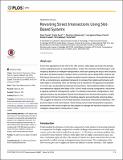| dc.contributor.author | Santi, Paolo | |
| dc.contributor.author | Sobolevsky, Stanislav | |
| dc.contributor.author | Frazzoli, Emilio | |
| dc.contributor.author | Helbing, Dirk | |
| dc.contributor.author | Ratti, Carlo | |
| dc.contributor.author | Tachet des Combes, Remi | |
| dc.contributor.author | Reyes Castro, Luis Ignacio | |
| dc.date.accessioned | 2016-04-28T11:28:19Z | |
| dc.date.available | 2016-04-28T11:28:19Z | |
| dc.date.issued | 2016-03 | |
| dc.date.submitted | 2015-10 | |
| dc.identifier.issn | 1932-6203 | |
| dc.identifier.uri | http://hdl.handle.net/1721.1/102298 | |
| dc.description.abstract | Since their appearance at the end of the 19th century, traffic lights have been the primary mode of granting access to road intersections. Today, this centuries-old technology is challenged by advances in intelligent transportation, which are opening the way to new solutions built upon slot-based systems similar to those commonly used in aerial traffic: what we call Slot-based Intersections (SIs). Despite simulation-based evidence of the potential benefits of SIs, a comprehensive, analytical framework to compare their relative performance with traffic lights is still lacking. Here, we develop such a framework. We approach the problem in a novel way, by generalizing classical queuing theory. Having defined safety conditions, we characterize capacity and delay of SIs. In the 2-road crossing configuration, we provide a capacity-optimal SI management system. For arbitrary intersection configurations, near-optimal solutions are developed. Results theoretically show that transitioning from a traffic light system to SI has the potential of doubling capacity and significantly reducing delays. This suggests a reduction of non-linear dynamics induced by intersection bottlenecks, with positive impact on the road network. Such findings can provide transportation engineers and planners with crucial insights as they prepare to manage the transition towards a more intelligent transportation infrastructure in cities. | en_US |
| dc.language.iso | en_US | |
| dc.publisher | Public Library of Science | en_US |
| dc.relation.isversionof | http://dx.doi.org/10.1371/journal.pone.0149607 | en_US |
| dc.rights | Creative Commons Attribution | en_US |
| dc.rights.uri | http://creativecommons.org/licenses/by/4.0/ | en_US |
| dc.source | PLoS | en_US |
| dc.title | Revisiting Street Intersections Using Slot-Based Systems | en_US |
| dc.type | Article | en_US |
| dc.identifier.citation | Tachet, Remi, Paolo Santi, Stanislav Sobolevsky, Luis Ignacio Reyes-Castro, Emilio Frazzoli, Dirk Helbing, and Carlo Ratti. “Revisiting Street Intersections Using Slot-Based Systems.” Edited by Tieqiao Tang. PLoS ONE 11, no. 3 (March 16, 2016): e0149607. | en_US |
| dc.contributor.department | Massachusetts Institute of Technology. Department of Aeronautics and Astronautics | en_US |
| dc.contributor.department | Massachusetts Institute of Technology. Department of Urban Studies and Planning | en_US |
| dc.contributor.department | Massachusetts Institute of Technology. Laboratory for Information and Decision Systems | en_US |
| dc.contributor.department | Massachusetts Institute of Technology. SENSEable City Laboratory | en_US |
| dc.contributor.mitauthor | Tachet des Combes, Remi | en_US |
| dc.contributor.mitauthor | Santi, Paolo | en_US |
| dc.contributor.mitauthor | Sobolevsky, Stanislav | en_US |
| dc.contributor.mitauthor | Reyes-Castro, Luis Ignacio | en_US |
| dc.contributor.mitauthor | Frazzoli, Emilio | en_US |
| dc.contributor.mitauthor | Ratti, Carlo | en_US |
| dc.relation.journal | PLOS ONE | en_US |
| dc.eprint.version | Final published version | en_US |
| dc.type.uri | http://purl.org/eprint/type/JournalArticle | en_US |
| eprint.status | http://purl.org/eprint/status/PeerReviewed | en_US |
| dspace.orderedauthors | Tachet, Remi; Santi, Paolo; Sobolevsky, Stanislav; Reyes-Castro, Luis Ignacio; Frazzoli, Emilio; Helbing, Dirk; Ratti, Carlo | en_US |
| dc.identifier.orcid | https://orcid.org/0000-0003-2026-5631 | |
| dc.identifier.orcid | https://orcid.org/0000-0002-0505-1400 | |
| dc.identifier.orcid | https://orcid.org/0000-0002-5209-1843 | |
| dc.identifier.orcid | https://orcid.org/0000-0001-6281-0656 | |
| mit.license | PUBLISHER_CC | en_US |
